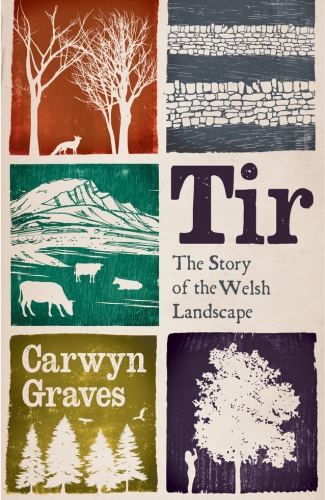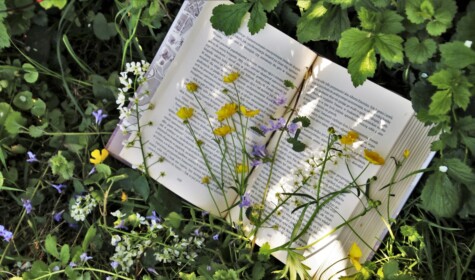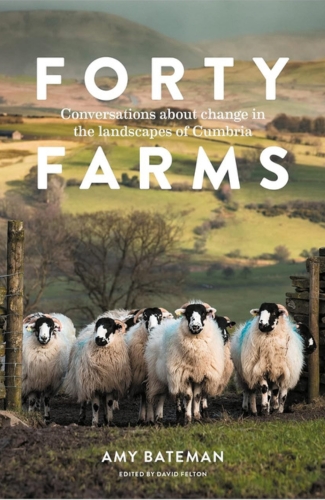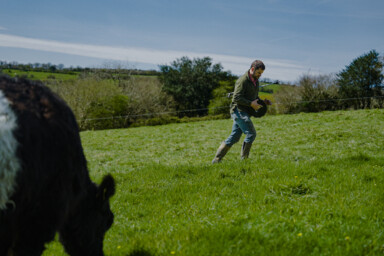Another year brings another brand new batch of books, carefully selected, read and reviewed by the SFT team. Find out what should be at the top of your TBR (to be read) list this summer.
 Tir: The Story of the Welsh Landscape
Tir: The Story of the Welsh Landscape
Carwyn Graves
Reviewed by Isabel Eaton
For many people, the jagged mountains, deep valleys and pony-dotted hillsides of Wales represent a place in which to connect with nature and unwind. For others, however, the Welsh countryside is a stark reminder of the damage that humans have wreaked upon the land through intensive farming and industry. In Carwyn Graves’ latest book, Tir, the author explores the realities of the Welsh landscape, past and present, revealing how humans have shaped the terrain for millennia.
Across seven chapters, each uncovering a different element of the Welsh landscape, Graves celebrates the diverse ecosystems of his homeland, revealing how the land has been transformed by humans ever since they first began harvesting wood and herding animals. Using the Welsh names for each habitat, along with an approximate English translation – including Coed (native woodland), Mynydd (mountain or moor), Cloddiau (hedgerows) and Perllan (planted fruit-bearing woodland) – Graves interweaves history, ecology and poetry with the stories of the farmers and nature lovers who he meets along the way, demonstrating the inextricable links between the land, farming and culture in Wales.
Graves looks at how the country-wide shift from traditional mixed farms with carefully managed infield-outfield systems to mass livestock farming – primarily of sheep – has taken its toll. He believes that there is much to be learnt from how Wales was once farmed and that by using the right animals in the right places, increasing tree cover and farming in harmony with nature, agriculture can be an effective, culturally sensitive and socially just means of managing and restoring the Welsh landscape.
Graves draws upon the example of Troed y Rhiw Organics in Ceredigion, run by the Sustainable Food Trust’s Editor, Alicia Miller, and her partner Nathan Richards. The couple have established a thriving low-input vegetable-growing business, supported by a small number of cattle and pigs that fertilise the land and provide the family with home-reared meat. Birds, bats and insects live in balance on the farm, creating a healthy ecosystem where pests pose fewer problems, and the naturally poor-quality soil is able to produce sufficient varied and delicious crops to keep a successful veg box scheme running.
Graves suggests ten actions that could be applied at landscape-scale across Wales to enable farming to protect and enhance the environment – from rewarding nature-friendly farming practices, to investing in farmer education, rewetting peatland and increasing vegetable production to enable self-sufficiency. Through application of these measures, Graves envisages a thriving Welsh landscape where the land will be used, not abused, by those who occupy it, and the diverse ecosystems of the country can thrive once more.
The Lost Supper: Searching for the Future of Food in the Flavors of the Past
Taras Grescoe
Reviewed by Alicia Miller
Taras Grescoe’s The Lost Supper is an exploration of foods that over centuries have slowly disappeared and with them tastes and flavours that we, as a species, have now mostly long forgotten. The author’s journey into landscapes of the past and the foods they provide takes him far and wide – starting in Çatalhöyük where humans first settled on the land becoming place-based, cultivating emmer wheat and barley, yet still hunting and foraging their food. Agriculture had not yet quite arrived as a practice and food was abundant.
Grescoe’s premise is arguably about the re-invention of agriculture, by better understanding the importance of diversity in the food we eat. The Lost Supper is a travelogue of the food journeys that Grescoe makes around the world in his search for what has been ‘lost’ in some capacity or other. From Mexico, in search of the axayacatl water bug, to Cadiz to recreate ‘putrescence’ – a flavour loved by Romans, but difficult to replicate and possibly disgusting – to the dying olive groves of Puglia in Italy and beyond, along the way discovering rare pigs, peculiar herbs and simple bread and cheese.
Grescoe writes that “The genetic riches of forgotten and near-lost foods offer real hope for future food security. I wanted to know what our ancestors ate, and what our prehistoric and historic diets could tell us about what we are as a species and where we need to go.” We have indeed lost the meaning and importance of food in an increasingly homogenised landscape of ultra-processed products, and this is something we should be deeply concerned about. While Grescoe’s search is somewhat extravagant in its meanderings, revisiting the strange flavours, character, tastes and practices of food production and preservation through the ages and the stories that they tell, will ultimately encourage us to eat differently and diversely.
Hedgelands: A Wild Wander Around Britain’s Greatest Habitat
Christopher Hart with Jonathan Thomson
Reviewed by Alicia Miller
Christopher Hart and Jonathan Thomson explore the history and wonders of the hedgerow in Hedgelands. Hart describes the hedgerow as “a green food bank, a wind break, a stock fence, a flood defence system, an immense storage unit for excess carbon dioxide, and an incomparable haven for wildlife”. The book is a varied exploration of the hedgerow and all it offers, also detailing the many ways of laying hedges.
Hedgerows are some of our most critical infrastructure for nature. It is thought that hedge laying may have stretched back as far as 4,500 years and it remains a vital component of British landscapes. But in recent decades, many hedgerows have been in slow decline, even ripped out and destroyed in certain areas. They deserve our attention because what they provide is vital to our wider ecosystems – if you care about nature in Britain, you should care about our hedgerows.
Hedgerows are traditionally man-made from a combination of thickets and woodland, but they can have a broad range of differing features. How they are managed is dependent on who is managing them and how much care is given – often, very little. Unfortunately, most hedgerows are now flailed in the autumn, a brutal process that is likely to leave them “degraded habitat” according to the charity, Buglife.
Most importantly, hedgerows host diverse ecosystems across the UK, and they are a vital protectorate of nature. As we watch all kinds of nature fall into decline, the importance of preserving hedgerows becomes ever more vivid and critical. Modern farming has had a broad and largely terrible impact on these neglected ecosystems, from birds to bugs to flora and fauna. The hedgerow remains a quiet saviour in many parts of Britain, and we should value their presence and commit to reviving and restoring them.
Remembering Peasants: A Personal History of a Vanished World
Patrick Joyce
Reviewed by Victoria Halliday
What springs to mind when you hear the word ‘peasant’? Often, it is used to imply contempt, conjuring up a picture of someone who is ‘backward’, uncivilised or of low social standing. Yet, as Patrick Joyce explains, the word in its true sense means simply ‘country people’ or people of the land.
Joyce’s book, Remembering Peasants, sets out to document this fast-vanishing population, which has been devastated by social change, war and the relentless expansion of industrial agriculture. Peasant communities – which still encompass over 1 billion individuals globally – are hugely varied and not easily categorised in a social, economic or political sense. Some live in abundance while others endure conditions of “near-perennial scarcity”; some are employers while others are employed (or enserfed); some have claim to their own land, others are landless.
Joyce highlights that there are, however, commonalities that hold true across peasant societies – cooperation as fundamental to survival, the sense of a common fate, connection to land, a non-linear notion of time and vulnerability to exploitation by others. Peasant communities typically adhere to long-established conventions that today we might consider stifling, but the author challenges the idea that these communities are resistant to change; the constant need to improvise in the face of uncontrollable forces means that they are more adaptive and flexible than commonly understood.
From music, storytelling and sacred beliefs to land, labour and food, Joyce unwinds the threads of peasant life – a life shaped by deep connectivity won through fierce hardship. The book focusses on Ireland, Poland and Italy, where peasant culture clung – or is clinging – on, and also explores the history of Joyce’s own ancestors, whose roots are in the peasant communities of Ireland’s far west. Theirs is a story of love of place, entwined with struggle, emigration and fragmentation, paralleling the experience of millions of others during the 20th century.
While taking pains to avoid a nostalgic view, Remembering Peasants invites us to question what has been lost in the face of techno-industrial advancement. Today, many descendants of those who were swept towards urban centres with promises of prosperity and emancipation, are experiencing not only economic powerlessness and political disenchantment, but a deep sense of social and spiritual dislocation. Does the vanishing of peasants represent real progress? That is for us, the reader, to decide.
Field, Fork, Fashion: Bullock 374 and a Designer’s Journey to Find a Future for Leather
Alice V Robinson
Reviewed by Alice Frost
In this era of fast fashion, where powerhouses like Shein and Pretty Little Thing dictate much of the online market, generating profits of up to $2 billion a year – despite emitting more pollution than the entire country of Paraguay – and when mass consumerism is so deeply embedded in our purchasing habits, it’s more normal than not for the average consumer to give little thought or care towards where our clothes come from and how they’ve been made.
On a mission to reconnect this forgotten link between our clothes and their provenance, in Field, Fork, Fashion, Alice Robinson, a London College of Fashion graduate, sets out to create a collection made entirely of leather from the hide of a single bullock: “Describing leather as a ‘by-product of the meat industry’ was not enough for me. What would it look like to work, from start to finish, with natural materials that came from the land around me?”
The inception of Robinson’s collection begins at Charity Farm in the Welsh countryside, where we meet third-generation farmer, Malcolm Adams, who in a few weeks’ time would be taking three of his cattle to the abattoir. One of these, a Longhorn Limousin cross, who would later come to be known as Bullock 374, was purchased by Robinson.
Each stage of the production process is described in meticulous detail, from the farm to the abattoir, to the tannery and finally the making of Collection 374 – a month-long process whereby Robinson and Stephanie, the “all-knowing, never-flustered, meticulous leather worker”, expertly craft four sides of leather into a coat, a jacket, three pairs of shoes, two handbags, two belt bags, two card holders, two key fobs and a purse. Robinson never shies away from recounting the sometimes gorier details of the process. Each person who plays their part in the transformation of Bullock 374 into Collection 374 demonstrates a genuine respect and admiration for the animal – Malcolm describes it best when he’s at the abattoir with Robinson and says, “The last day is as important as all the others”.
You can’t help but be awestruck by Robinson’s infectious drive and dedication to creating this collection (which can be seen in all its glory on the final pages). Field, Fork, Fashion makes for a truly inspiring read, encouraging us to take a beat the next time we’re out shopping or scrolling through retailers online, and reconsider how we can make more thoughtful and sustainable decisions, not just about our staple leather pieces, but about all our clothes and appreciate all that goes into producing them.
In case you missed it…
Forty Farms: Conversations about Change in the Landscapes of Cumbria
Amy Bateman
Reviewed by Bonnie Welch
In 2020, artist, farmer and writer Amy Bateman set out on a 12-month project to record a collection of farm stories from across Cumbria. From sheep grazers on the commons, to award winning dairy farmers and isolated farmsteads, Forty Farms paints a thoughtful and emotive picture of farming in a post-Brexit Britain.
Originally published in September 2022, the book contains over 500 photographs, many of which are now on display as part of an immersive exhibition at the Food Museum in Suffolk until February 2025, as well as being available to view online.
One of the farms mentioned in the book is Cannerheugh Farm in Renwick, a 360-acre farm, where Nic and Paul Renison produce 100% pasture-fed beef, as well as pastured eggs, chicken and pork. Cannerheugh, also one of the Sustainable Food Trust’s Feeding Britain case study farms, was managed conventionally until 2013, when, in an attempt to improve profitability, Nic and Paul decided to move to a rotational grazing system, which also led to significant increases in biodiversity and improved animal welfare.
Forty Farms showcases a diversity of farm enterprises, production methods, scales and landscapes, from the fertile Eden Valley where Cannerheugh can be found, to the saltwater marshes and rocky uplands. The book also features a range of farmers, from new entrants getting to grips with the landscape to older farmers struggling with issues of succession. A particular challenge for many farmers in Cumbria, is balancing food production with nature, in an area renowned internationally for its natural beauty.
Millions of people visit Cumbria each year, many of whom will visit the Lake District National Park, a landscape shaped by generations of upland hill farming. And yet few visitors will know of the cultural significance of these traditional farming practices, nor the role that farmers and land managers play in protecting and enhancing natural resources, including biodiversity, soil carbon and water quality.
To ensure land continues to be managed and farmed in a sustainable way, farmers need to be recognised for their role as stewards and rewarded for taking care of the environment. Forty Farms and its touring exhibition provides a way for the public to see behind the farm gate. Perhaps we need a Forty Farms for all corners of the UK to showcase farming in all shapes and sizes, and to enable the public to understand more about the stories behind their food.
More books for your shelf
The Wisdom of Sheep & Other Animals
Rosamund Young
“Be transported to the wild meadows of Kite’s Nest Farm and peek into the surprising private lives of some of our most familiar of animals. A life-enhancing read from the author of the bestselling gem The Secret Life of Cows.”
In Search of the Perfect Peach: Why Flavour Holds the Answer to Fixing our Food System (COMING SOON)
Franco Fubini
“The first bite of a perfectly ripe peach can be truly transformative – a joyful experience that stays with you forever. But, as Franco Fubini came to realise, flavour is a signifier of so much more than nostalgia. It has the power to change the way we grow, shop and eat – transforming the planet as well our palates.”
Being With Cows: How Grief Became Gratitude
Dave Mountjoy
“Being With Cows details the incredibly moving story behind the tragic death of one man’s brother and how his personal quest for inner healing came to him unexpectedly on his organic farm in the French Pyrenees.”
Dr Jenny Goodman
“Getting Healthy in Toxic Times asks the question that very few doctors do – how can we protect ourselves from the pollution, chemicals and toxins that pervade our environment?”












